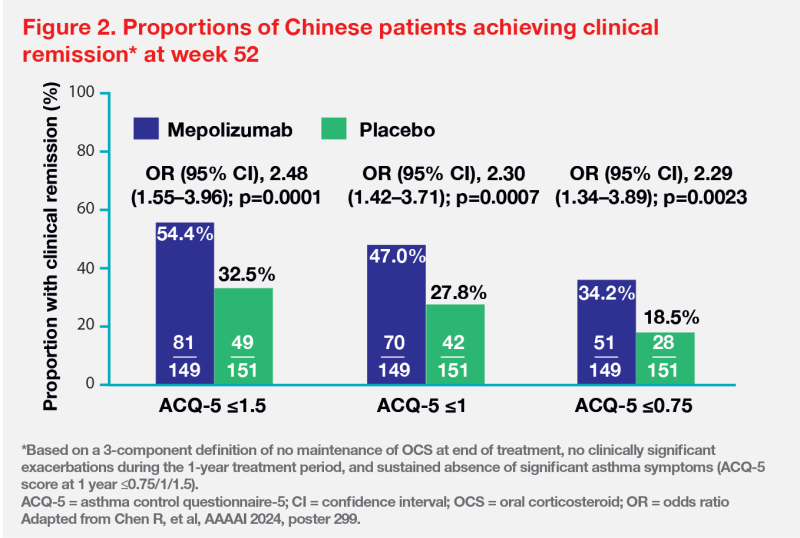Achieving clinical remission in severe asthma: What’s new in Asian population?









Associated eosinophilic inflammation, plays a crucial role in the pathogenesis of severe asthma, current standard-of-care management may not adequately address this important pathogenic contributor. At the 28th Congress of the Asian Pacific Society of Respirology, Professor Ian Pavord from the University of Oxford, UK, discussed how early treatment of underlying inflammation in asthma with biologics, such as the anti–IL-5 biologic mepolizumab, may facilitate clinical remission and improve patient outcomes, especially in the Asian population. Dr Ken Chan from the Chinese University of Hong Kong highlighted the unique characteristics of Asian asthma patients and emphasized the importance of phenotyping in guiding use of biologics.
“People remodelling” in severe asthma
Asthma is a common airway inflammatory disease affecting 300 million patients worldwide, of whom approximately 5–10 percent have severe disease (ie, uncontrolled despite Global Initiative for Asthma [GINA] Step 4 or 5 treatment), which often involves increased use of short courses of oral corticosteroids (OCS). [J Asthma Allergy 2023;16:173-182; Global Initiative for Asthma Report 2024, https://ginasthma.org/2024-report/]
“Severe persistent asthma does not only cause airway remodelling that contributes to progressive loss of lung function and irreversible airflow obstruction. Cumulative dose of OCS is also associated with long-term complications, including mood changes, weight gain, and increased risks of osteoporosis, fractures and diabetes mellitus, thus inducing a debilitating process of ‘people remodelling’ – a concept that represents the utter disruption of people’s lives,” said Pavord. “Since OCS toxicity is difficult to reverse, even after cessation, early disease control is crucial to prevent the need for OCS and the associated consequences of people remodelling.” [J Allergy Clin Immunol 2005;116:477-486;quiz 487; touchREVIEWS in Respiratory & Pulmonary Diseases 2022;7:44-47; J Allergy Clin Immunol Pract 2024;S2213-2198]
Type 2 phenotype in severe asthma
More than 80 percent of patients with severe asthma are estimated to have the type 2 (T2)–high phenotype, defined as asthma where type 2 inflammation predominates. Type 2 inflammation is driven by T-helper 2 (Th2) responses mediated by cytokines, including IL-4, IL-5 and IL- 13, and eosinophil infiltration of the airways is accompanied by elevations of blood eosinophil count (BEC) and fractional exhaled nitric oxide (FeNO). [Chest 2021;160:814-830; Explor Asthma Allergy 2024;2:399-409; Am J Respir Crit Care Med 2009;180:388-395]
Prevalence in the Asian population
The multicentre, cross-sectional, observational PREPARE study in Hong Kong (n=232) revealed that 67.2 percent of Chinese patients with severe asthma had eosinophil levels of ≥150 cells/mm3 at one time point. Similarly, a comparison of phenotypes in severe asthma cohorts showed that Asian patients were older and had less female predominance and higher eosinophil count compared with patients from the US, Europe, and South America. [J Asthma Allergy 2023;16:173-182; Allergy Asthma Immunol Res 2024;16:338-352]
“Although the prevalence of eosinophilic phenotype among patients with severe asthma in Hong Kong was comparable to that reported in other populations, Asian asthmatics have unique physical and clinical characteristics compared with non-Asian populations,” Chan noted.
Notably, data from the Chinese Biomarkers for the Prediction of Respiratory Disease Outcomes (C-BIOPRED) cohort (n=452) revealed that T2-high asthma was the predominant phenotype (up to 75.7 percent) among severe asthma patients, and 38.5 percent of them were eligible for ≥1 biologic therapies targeting the type 2 inflammation pathway. [Chin Med J (Engl) 2023;136:230-232]
According to cross-sectional studies conducted in Hong Kong and Saudi Arabia, the prevalence of type 2 inflammation–related comorbidities, such as rhinitis (93 and 65 percent), nasal polyps (10 and 26 percent), atopic dermatitis (18 and 3 percent) and eczema (8 and 2 percent), was quite different between the respective regions. [J Asthma Allergy 2023;16:173-182; J Asthma Allergy 2023;16:173-182; BMC Pulm Med 2022;22:67]
“Proper phenotyping, especially in Asian patients, is important for guiding appropriate biologic treatment by targeting specific pathways in type 2 inflammation to achieve treatment goals,” Chan noted.
Clinical remission in asthma
“Current asthma treatment is symptom-driven, using a treat-to-failure approach. Although regular inhaled corticosteroid use can achieve guideline-defined control and reduce exacerbations, adherence to asthma medications is frequently low in practice, increasing the risk of exacerbations, OCS dependence, and airway and people remodelling,” Pavord commented. According to the International Severe Asthma Registry, regular OCS use remains common in some Asian countries, while biologics are not widely prescribed. [Chest 2020;157:790-804]
“Remission is a well-defined therapeutic target in many chronic inflammatory conditions, such as rheumatoid arthritis and inflammatory bowel disease, but it is not yet a well-recognized target in asthma management despite having been investigated extensively,” Pavord commented.
Asthma remission is characterized by a high level of disease control, including absence of symptoms and exacerbations, optimization of lung function, and sparing of OCS with or without ongoing treatment. [Eur Respir J 2022;60:2102583] “The concept of asthma remission is consistent with GINA’s long-term treatment goal. Research suggests that clinical remission in severe asthma is a plausible treatment target achievable with biologics. Early intervention with biologics, especially before comorbid disease associated with OCS exposure accumulates or ‘remodelling’ occurs [eg, at or before GINA Step 4 treatment], may alter the disease trajectory,” Pavord explained.
Factors affecting asthma remission
An analysis of the UK Severe Asthma Registry found that female patients, those with longer symptom duration (≥10 years), comorbid depression or anxiety, obesity (≥30 kg/m2), and ≥2 OCS bursts for exacerbations in the year prior to using biologics were less likely to achieve clinical remission. In contrast, clinical remission was more likely in patients with high disease activity in terms of type 2 biomarkers (FeNO ≥20 ppb or BEC ≥150 cell/mm3 or both). [Eur Respir J 2023;62:2300819] “The data suggest that clinical remission is a realistic target in patients with an eosinophilic phenotype treated with biologics,” Pavord noted.
Biomarkers for exacerbation risk or disease activity
The Oxford Risk of Asthma Attack Scale (ORACLE), derived using pooled data from five studies (n=3,051), is a risk scale that predicts asthma attacks with BEC and FeNO, irrespective of asthma symptoms and lung function measurements. Each cell in the risk scale represents the predicted annual asthma attack rate for patients ≥12 years of age if treatment is not changed. “The risk scale shows that patients with elevations in both BEC and FeNO have 3–4 times higher risk of asthma attacks or exacerbations due to type 2 inflammation,” said Pavord. (Figure 1) [Thorax 2022;77:199-202]

“Assessing disease activity routinely using the ORACLE scale , especially at diagnosis, will help swiftly identify patients with high disease activity and allow early intervention with biologics to achieve clinical remission and prevent remodelling in a personalized manner,” Pavord suggested.
Clinical remission attainable with mepolizumab
Mepolizumab is an IL-5 antagonist that reduces type 2 inflammation by reducing production and survival of eosinophils through inhibiting IL-5 signalling. Randomized clinical trials, including DREAM, MENSA and SIRIUS, consistently demonstrated efficacy of mepolizumab in reducing exacerbations and exacerbation-related hospitalizations as well as improving asthma symptoms, lung function and quality of life. Importantly, a secondary analysis of the DREAM and MENSA studies showed that exacerbation rate reduction with mepolizumab vs placebo increased from 52 percent in patients with BEC ≥150 cells/ mm3 to 70 percent in patients with BEC ≥500 cells/mm3, suggesting that patients with higher BEC have higher disease activity and are more likely to achieve remission with mepolizumab. “These patients who are more likely to benefit from mepolizumab can be readily identified by biomarker assessments,” emphasized Pavord. [Lancet 2012;380:651-659; N Engl J Med 2014;371:1198-1207; Lancet Respir Med 2016;4:549-556; N Engl J Med 2014;371:1189-1197]
Chinese data
A randomized, double-blind, placebo-controlled, multicentre, phase III study evaluated mepolizumab in 300 Chinese patients with severe asthma and elevated baseline BEC. After 52 weeks of treatment, the rate of asthma exacerbations was reduced by 65 percent with mepolizumab vs placebo (rate ratio, 0.35; 95 percent confidence interval, 0.24–0.50; p<0.001). In addition, a higher proportion of patients in the mepolizumab vs placebo group experienced ≥50 percent reduction in exacerbations from baseline (90.6 vs 70.2 percent). [ERJ Open Res 2024;10:00750-2023]
Post-hoc analysis of the same study demonstrated that 54.4 percent of Chinese patients achieved clinical remission with mepolizumab (vs 32.5 percent with placebo), where clinical remission was defined as having no maintenance OCS at the end of 1 year of treatment, no clinically significant exacerbations during the 1 year of treatment and sustained absence of significant asthma symptoms in terms of asthma control questionnaire (ACQ)-5 score value at 1 year ≤0.75/1/1.5. Irrespective of the ACQ threshold definition of asthma control, mepolizumab was significantly better than placebo in achieving a remission level outcome. (Figure 2) [Chen R, et al, AAAAI 2024, poster 299]

Summary
Phenotyping using type 2 biomarkers (BEC and FeNO) can identify asthma patients with eosinophilic inflammation and higher disease activity who are more likely to benefit from treatment with biologics. Remission is a valid and achievable goal in this population, including in Asian patients, and it can be facilitated through early intervention with biologics, such as mepolizumab, through inhibition of IL-5. By targeting the correct biology, there is the potential to alter future disease trajectory and prevent people remodelling, but longer-term outcome studies are needed to conclusively determine this.